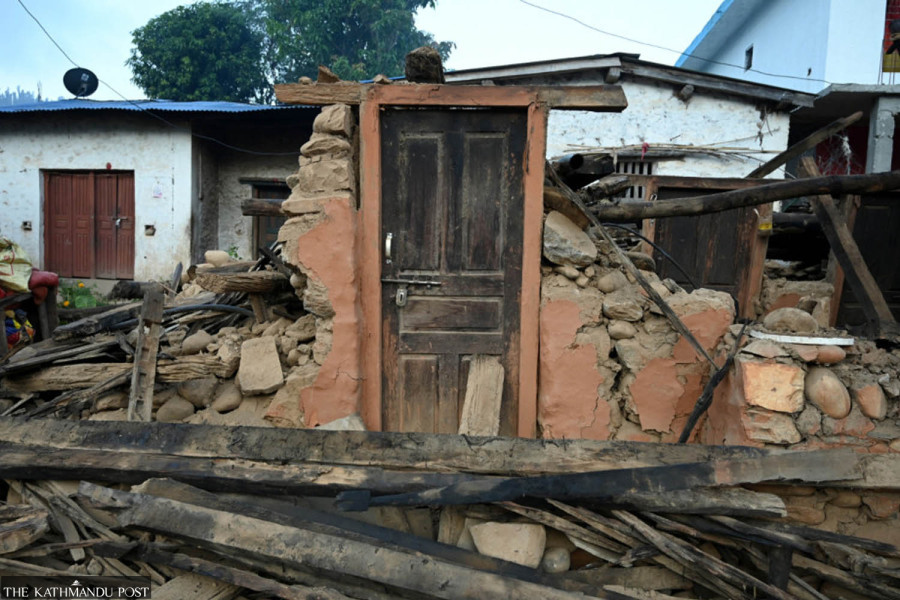Columns
State of unpreparedness
The Jajarkot quake proved the rationale of federalism with generously devolved power to local governments.
Achyut Wagle
Nepal has yet to fully recover from the devastating earthquakes of 2015, and the country was hit by a major 6.4 magnitude earthquake late on Friday, with its epicentre in Jajarkot—one of the remotest districts in Karnali province. As per the reports, there have been 153 casualties, with several more injured and hundreds of thousands left homeless in Jajarkot and Rukum West districts. The harrowing tales of survivors, security and rescue personnel manifest the severe deficit in transport, health and rescue/relief infrastructure in this difficult and rugged mountain terrain. Relief workers agree that many lives could have been saved if there were adequate and functional hospitals in the area. Unfortunately, the nearest full-fledged hospital is in Surkhet, a six-hour drive from the epicentre.
The approaching winter and physical barriers have compounded the challenges. As a result, immediate, effective and sufficient rescue, relief and rehabilitation (3R) operations fell short and substantial time lag commensurated to the scale and impact of the disaster.
It is perhaps a universal phenomenon that the poor are most vulnerable to natural disasters, including floods, hurricanes, typhoons, wildfires and others. In Jajarkot and neighbouring districts, abject poverty manifests in the mud-stone, thatched-roof huts where most of the population is sheltered.
Institutional mechanism
Nepal, despite being situated in one of the most seismic-prone areas of the earth, has perhaps the poorest disaster response mechanism and has largely failed to institutionalise the structures for the 3R operations. The existing emergency operations and their mechanisms are not only ill-equipped regarding human and technical skills but also suffer from fragmented or, at times, overlapping legal mandates.
For instance, the National Council for Disaster Risk Reduction and Management, headed by the prime minister, functions as a loose advisory government mechanism for disaster relief. A supposedly autonomous National Disaster Risk Reduction and Management Authority (NDRRMA) was established four years ago and is, again, chaired by the prime minister. Under this is the Disaster Risk Reduction and Management Executive Committee headed by the home minister. The ministry also runs the Emergency Operations Centres (EOCs) in all seven provinces. Similarly, a provincial disaster management committee under the chief minister, a district disaster management committee under the chief district officer in all 77 districts, and a local disaster management committee under the head of each of the 753 municipalities have been set up as per the provisions of the Disaster Risk Reduction and Management Act, 2017. Major security organisations—Nepal Army, Nepal Police and Armed Police Force—also have units dedicated to rapid disaster response. The government also has a billion-rupees relief fund.
But every time a disaster strikes, chaos and confusion mar the coordination among key government agencies without set institutional mechanisms and defined processes. A fully efficient institution for what is popularly known as the four Ps—policy, planning, preparedness and pre-warning on a permanent basis is a national need.
Lesson not learned
The office of the National Reconstruction Authority (NRA), instituted after the 2015 earthquake with a lofty mandate of “build-back-better”, was dissolved in December 2021. It apparently failed to even deliver on its promises of reconstructing all the demolished individual houses, let alone developing organised resettlements to relocate the victims to safer locations. Many heritage sites, infrastructures, facilities, schools and hospitals remain to be rebuilt. The amount spent by the NRA and the quality of the final work are blatantly suboptimal, to say the least. The politically instigated game of musical chair to head it with every change in government had a telling effect on its overall outcome. The new entity, NDRRMA, too, appears to be a famished child of the NRA.
In essence, the Nepali state failed to learn indispensable lessons from past disasters like the 2015 Gorkha earthquake and the 2021 Melamchi floods, among other big natural disasters. Plans for permanent relocation of settlements without jeopardising the cultural heritage and providing means of livelihood to the people were never featured as part of the national policy on disaster management. Research and forecasting mechanisms are virtually non-existent. Policy calibration, capacity building of the government of all three tiers and preventive education to the populace vis-à-vis disaster risk reduction and risk management are not part of national policy and planning exercises.
Even in the current context, immediately after the rescue and relief operations are over in Jajarkot and the vicinity, relocation, rehabilitation and (perhaps) resettlement (3R) will be the most pronounced needs. Due to pervasive poverty, with an average per capita income less than half of that of Kathmandu Valley, the post-disaster 3R needs will definitely be more acute than in the 2015 quake.
In many situations, such disasters are seen as a blessing in disguise to redesign cities and settlements and augment public services. Major crises like this draw national and international attention, which in turn helps to reinvigorate economic activities through increased mobilisation of resources, added consumption and speedy reconstruction. But Nepal, sadly, has failed to capitalise on any of such “opportunities”. On the contrary, there are instances where the assistance sent by our development partners also went unspent.
Nevertheless, one silver lining in the dark cloud is that the present disaster once again (after the Covid-19 pandemic) established the rationale of federalism with magnanimously devolved power to the elected subnational bodies, particularly the local governments. In every aspect—from search, rescue, and identification of the victims, mobilisation of relief materials and coordination among the agencies—these local-level executives and functionaries have left an indelible mark.
These are the practices and institutions that now need to be empowered, equipped and provided skills to make our disaster management practices sustainable. It is the subnational governments that can work to reduce the demand-supply mismatch in public services like health, infrastructure and utilities.




 19.12°C Kathmandu
19.12°C Kathmandu















